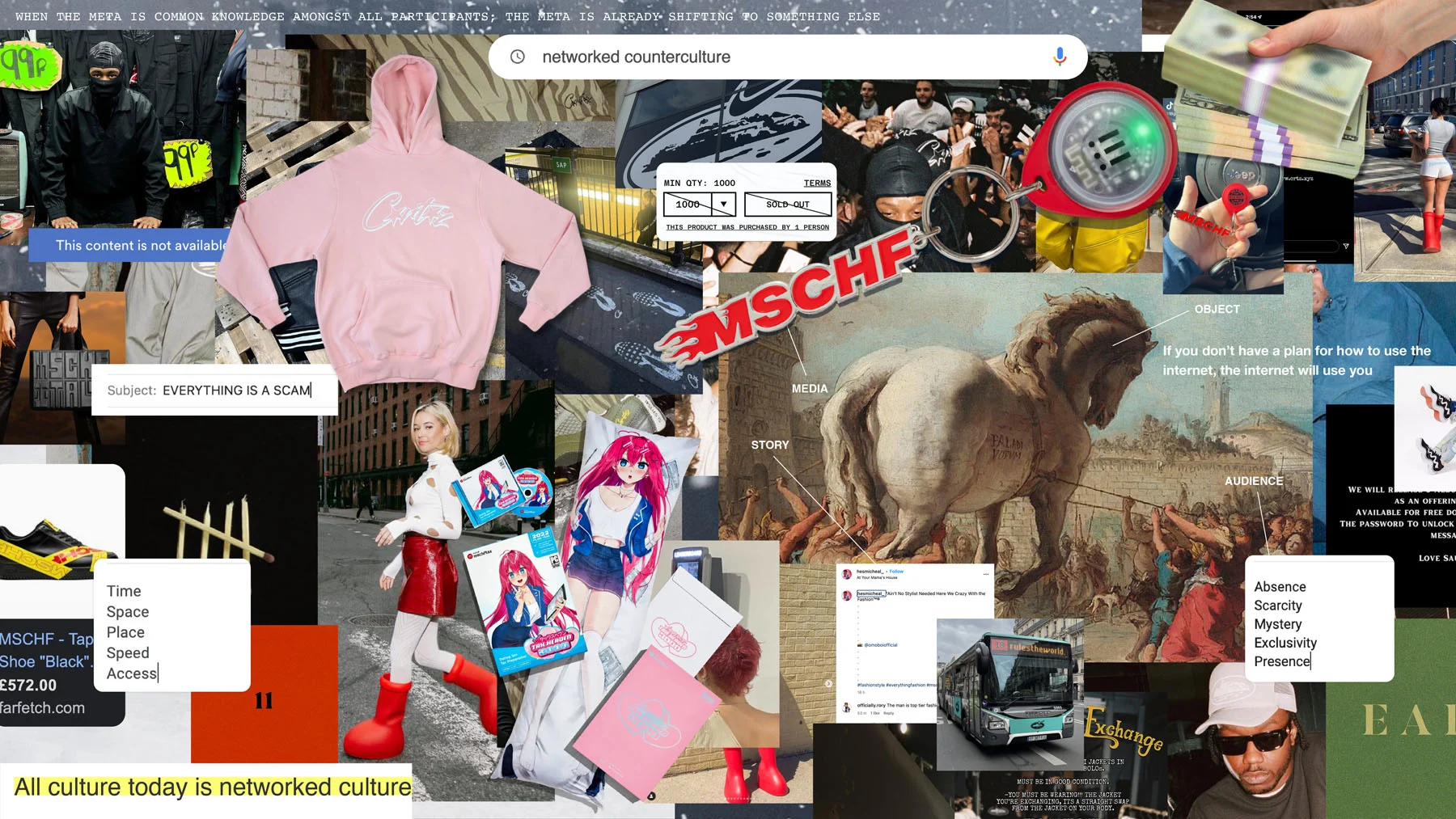

With many creatives feeling like their success—and their connection with their audience—is decided by the systems and algorithms of the platforms they use, it begs the question: Can you break the mold and still find success online? in our research memo “Networked Counterculture”, created in collaboration with co-matter we explore how some creators—Corteiz, MSCHF and SAULT, to name a few—are subverting these platforms, playing the algorithm at its own game and, most importantly, winning.
Many artists find themselves torn between pleasing algorithms and staying true to their work.
On February 20th, five days before the release of her third album, the American singer-songwriter Vérité posts a note on her Instagram titled "How do I get your attention?" In it, she describes how it feels to be an artist in the creator economy: the constant pressure to churn out bite-sized and digestible moments to get enough views, likes and comments in the desperate hope of connecting with your fans on a deeper, more meaningful level.
Verite isn't alone in her uneasy feelings about the platforms that mediate—and effectively own—the relationship between her and her fans. Many artists find themselves torn between pleasing algorithms and staying true to their work. Platforms that once promised to remove the middlemen and create more direct, authentic connections between artists and their audiences are now gatekeepers themselves.
We know we’re trapped. But strangely we’re also in love with our captors. As long as we stream, like, binge, lol and troll online, there’s a platform that feeds on our attention, algorithmically dissecting our habits to determine the type of content created on the other side of this infinite loop. If you don’t post, someone else will take your place in our global social arena where few make it to the top whilst the rest burn out. This is how the attention economy works. If you’re not visible online, you don’t exist. We keep on posting so we're not forgotten.

With our research into networked counterculture we sought to understand whether it could be different. Is it possible to exist in the network without compromising your artistic integrity? Is counterculture possible inside the system that turns us into perpetual content creators?
When you see MSCHF’s Big Red Boots you wouldn’t immediately think of counterculture. One of their latest drops, $320 gigantic red rubber boots inspired by 1960s comic character Astro Boy, seems to have no political or cultural agenda. Its sole purpose, it appears, is virally spreading through the network via countless influencer accounts. And yet there’s something about a MSCHF object that cuts through the noise in a way that feels different to your average engineered viral campaign. The Brooklyn art collective describes their own works as trojan horses: infiltrating a culture by mimicking its aesthetics, practices and norms. Once inside a network, they unleash their narrative potential, reeling us, the good people of the internet, to become participants in the spectacle.
Corteiz, the hugely successful streetwear and lifestyle project from South London, has a different approach to toying with the network. The tactics by which founder Clint419 draws thousands of fans to the streets for his latest drop might be hard to decipher but he makes his moves with complete understanding of the network he orchestrates. Access is strictly limited, participation happens IRL, presence is required, trust is earned. By playing against the rules of the platforms that want everything to be open, accessible and abundant, Corteiz succeeds by doing the exact opposite.

The most radical example of platform anarchy might be Sault. Despite millions of streams and award-nominated albums, the UK music collective remains nearly invisible online. There’s no content that keeps them afloat in the network, no channels to remind us that they exist. Their absence is a statement in itself.
What these three projects have in common is that they create cultural artifacts with a deep understanding of how their objects—their art, music, fashion—exist within the network. To them, the logic of the platforms that mediate culture aren't an afterthought; they're part of the process. Whilst everyone else is scrambling to succeed within platform confines, MSCHF, Corteiz and Sault operate beyond them. These three collectives use mass media and capitalism as artistic medium—playing with it, against it, and thus subverting the rules to regain power and agency over the relationship between their work and its audience.
Networked Counterculture is a piece of research we put together to provide an understanding of contemporary culture through the lens of the networks that mediate it.
The memo does not provide alternatives to the platforms that dominate, instead it shows how these platforms can be subverted by using their own logic against them. As these projects show, the one thing we know today is how the attention economy works. Once a system is exposed it can be subverted. Once you lose faith in a system it turns into a game. We might not know how the algorithm works, but we know what it wants. So why not play with it?
Or as Vérité puts it, in a post following her original note: “I would rather die playing my own game than succeed in playing somebody else’s unwinnable game.”

